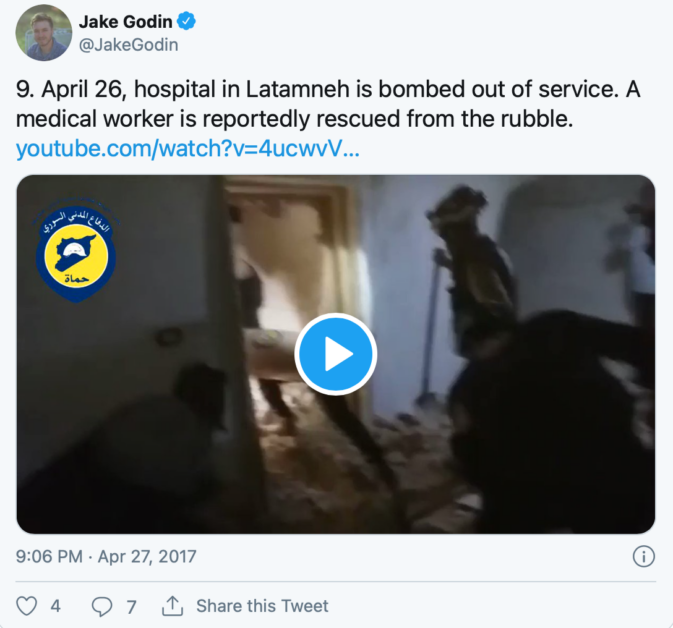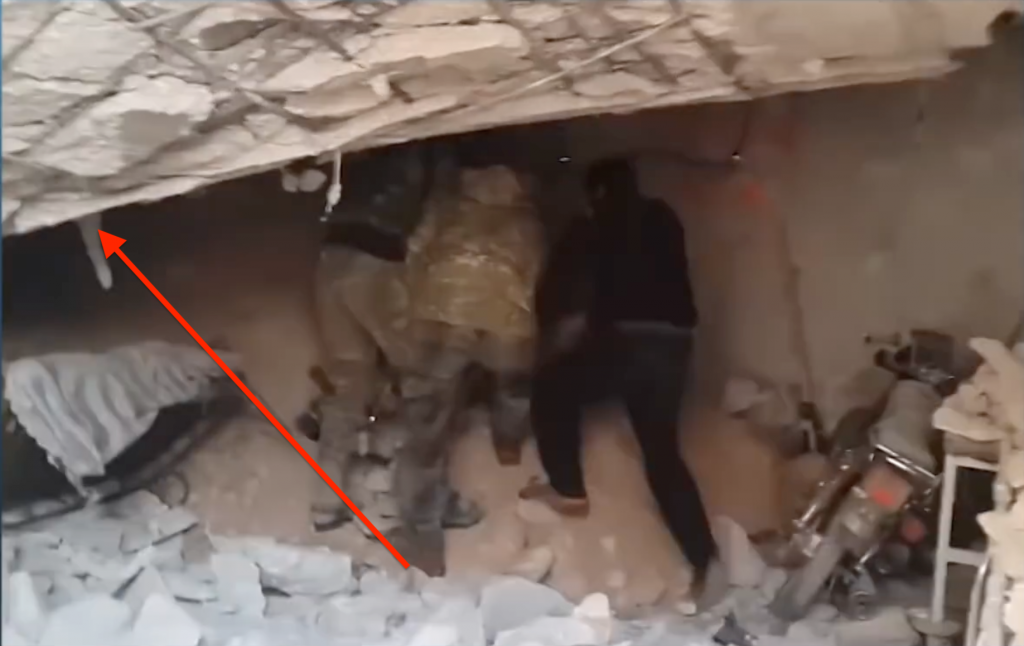Date of Report: July 26, 2020
Introduction
Those that follow our work will be aware that we have devoted a considerable amount of time to Lataminah and the alleged chemical attacks that occurred there in March 2017. With several in-depth reports still to come on the allegations, a matter that always caused us great concern was the claim that the Lataminah hospital was severally damaged on March 25 (after a chlorine cylinder allegedly penetrated the roof of the waiting area) and therefore attendance records, from the alleged sarin attack the day previous, were destroyed.
Even taking the claim and video footage from opposition sources at face value, combined they show little more than minor damage to the roof of a room that serves little purpose, given the video footage we have viewed. The opposition media sources unintentionally go as far as to provide evidence that their claims of medical record destruction was neither possible nor plausible.
However, the hospital did sustain a very heavy (likely) Russian aerial attack the following month, in April 2017, and given how difficult it was to find information on this event, due to its under-reporting, it raised our curiosity to find out more about what happened.
The reason why it’s important to ascertain what damage was caused, and when, is because the OPCW relies heavily on the hospital being that damaged on the 25th March that medical records, in relation to the alleged sarin attack the day before, were irretrievable.
In this report we review the video footage with the view to ascertaining if the evidence supports the OPCW’s claim that the hospital was so severely damaged on the 25th March that hospital records could have been lost.
Lataminah Hospital
The Location
Here’s an overview of the hospital’s location. In the satellite imagery below from Google Earth, note the hospital’s location (left) in connection with the alleged sarin attack locations of 24th & 30th of March. (Red balloon, right, denotes alleged crater for 30/3)

Next is a close up of the hospital entrance that appeared damaged in the footage:

This entrance consists of an outer “waiting room” that leads to a reception area and emergency room. To the left is the vehicle/ambulance entrance.
Here are ground level images showing the locations:
For this investigation we will be focusing on the “walk-in” entrance as that is where the cylinder was found.
The Entrance
This is the door into the waiting room with the red dot signifying the hole in the roof that allegedly was caused by the chlorine cylinder.

We’ve added a satellite image from Google Earth to give you a clearer understanding of the spot the chlorine cylinder is alleged to have struck.

Next are a few images from the underside of the crater and inside the room in question. You will note there is not a shred of evidence of any “medical records” being destroyed in this room.
What we would draw your attention to is the tunnel to the ambulance/vehicle entrance. There wasn’t a single entrance to the hospital, there was at least two.
OPCW – The Damage
One of the cylinders impacted the sand and concrete roof at the entrance to the hospital, leading directly to the Emergency Room (ER) at Ltamenah Hospital.
OPCW-FFM, S/1636/2018 page 17, 5.44
This is the first footage that appeared online showing the aftermath of the alleged chlorine attack:

This statement from the OPCW-FFM is quite shocking. This room was little more than a waiting area at best or, it seems, for picking up dead persons. It served no other purpose. There is no evidence either before or after the alleged 25th attack of anything relating to files and/or administration equipment in this room.
Here’s a video from THIQA news agency. Note how undamaged the hospital corridor is. I would also draw your attention to the reception area.
Just as the video ends you see the reception desk and immediately to the right of the desk you will see a doorway. That leads into the emergency room. Here’s a brightened image of the reception as recorded on the 25th March 2017, the day the chlorine cylinder was found.

According to the White Helmets, who spoke with both the FFM and IIT, the hospital was that badly damaged, the admittance records of those that attended the day before for the alleged sarin attack were destroyed.
It’s plausible to assume that the desk in the footage above acts as a kind of a “check-in” counter for admissions. As this desk is clearly undamaged, one must ask how records were destroyed? You can even see an unmarked cardboard box sitting on the counter, opened. With a hospital bed in front, also undamaged. There is no damage on the surrounding walls nor on the floor.
The Emergency Room
Below is a short clip of a cameraman approaching the reception area from inside the hospital. At the end he turns his camera to the left to view inside the ER. (Reduced Speed)
Next is footage from the 30th March showing a lady being treated in the emergency room after the alleged sarin attack.
Let’s do a quick comparison of images from both videos to confirm it is indeed the same room. (Click to open in larger window)

Pretty convincing, I’m sure you’ll agree.
Before moving on, let’s quickly see the outer room (where the cylinder was located) in ‘normal’ operation:
What can we learn from the above footage?
We know the room the cylinder was found in received little damage, and we also know there is no evidence supporting the idea that attendance records would be kept here, or indeed, were kept here. We also located the reception area, which was undamaged and the likely place where people would be admitted, and we located the ER.
The IIT has made efforts to locate the medical records of the patients allegedly affected by the chemical attack; however, this proved impossible because of the conditions of the hospital
OPCW-IIT S/1867/2020, page 35, 7.15
When Was the Hospital Destroyed?
On April 26th, 2017, is the short answer.
Many Syrian observers have questioned the allegations of chemical usage in Syria, especially the methodology and aims of deploying such crude and ineffective projectiles such as chlorine cylinders. The answer we consistently receive is that they are deployed to dislodge pockets of rebels that are proving difficult to clear out. We are also told they are deployed to create fear and to scare civilians away.
Neither of these two popular explanations can explain the alleged attack on the Lataminah hospital on 25th March 2017. Because the entrance was cleaned up and it was business as usual thereafter.
Evidence of its continued use can be noted from several sources, one of which is the OPCW and another is the video evidence.
Due to decreased capacity to treat patients further to the incident of 25 March 2017, the majority of cases were immediately transferred to other hospitals before any treatment or detailed evaluation took place.
OPCW-FFM Report 30 March 2017, S/2017/931, page 12, 5.19
As shown above, there is no way the hospital had a “decreased capacity” following the alleged 25 March attack. That said, we can gather from the FFM statement that the hospital was still able to take in alleged casualties of the 30 March attack. So it was still operational, taking all things at face-value.
Then we have video evidence of the hospital still operating in April 2017 when it sustained major damage in an aerial attack. Oddly, this went under-reported.
OSINT Evidence of April 26, 2017 Damage
Whilst researching the alleged Lataminah chemical attacks, I found this tweet pointing to 2 videos, one of which I had previously seen relating to the alleged 30/3/17 Sarin attack and the other posted by Bellingcat’s Jake Godin, that I had never seen before.

Here is the video Jake posted.
Along with this tweet:

What was odd is that, given Jake works for the NATO-State-funded Bellingcat and given they had written extensively about the Lataminah chemical allegations, they never reported once on the strike on the hospital on the 26th April 2017, even though Jake tweeted about it.

However, we needed more than this to prove it was actually the same hospital that is alleged to have been hit by a falling chlorine cylinder. So we began a very long and torturous slog through the archives of social media, which took many months to complete, in order to ascertain if it was indeed the same hospital.
Lataminah Hospital Attack, April 26
There is little footage left online, that we could find, of the damage sustained in this attack but what is left proved pivotal for this investigation.
Here is a clip from the 26th April 2017 of a cameraman walking away from rescuers through the hospital towards, what we recognised, as the entrance of the hospital where the cylinder was discovered.
What caught our attention immediately, apart from the familiar layout, was the reception desk/counter. We’d seen that in other footage from ANNA News.
Here is ANNA footage from of the hospital (after the government retook the area) which begins outside and approaching the entrance before the cameraman walks into the room the cylinder was found, then proceeds to walk in the direction of the reception desk.
It was immediately clear to us that the damage to the hospital shown in the Godin video was the same hospital as that of the alleged chlorine attack of 25th March 2017. However, it must be clear to you, the reader and it’s our job to ensure that is the case. Therefore, we needed more evidence.
By accident, we would happen to stumble across a news report that would prove the case decisively.
When we found the report we were in the process of transferring data to a new computer and somehow misplaced the footage. Not realising we had misplaced it, as it was still available on YouTube, we began poking around asking questions of a few sources with knowledge of the incident. The following day (after asking the questions) the footage would be deleted from YouTube having been there since 2018, untouched. We recall it had only ever received 58 views, it was that obscure.
Long story short, after weeks of searching we consigned ourselves to the belief that the video was gone forever and with its deletion, a piece of important piece of history of the Syrian conflict went with it. We would be lying if we said this wasn’t disheartening.
Then last week as I opened Final Cut Pro to do some unrelated work, there it was. I’d moved it into the Final Cut folder and forgotten!
Here is the segment of that news report that is important to this investigation:
Recall the video above that shows the cameraman walking towards the reception area from inside the hospital? You may have noticed he reaches a caved-in doorway?
That doorway is just behind the fallen roof:

Hopefully now you can see the hospital damaged in the April 2017 attack was the same hospital the chlorine cylinder was found in. However, it would go on to be rebuilt and remain as a functioning rebel field-hospital.
The Deleted Video
Here is the evidence that particular video was singled out for deletion.
The video, from Aleppo Today, was uploaded to YouTube on the 22 June 2018 and to Facebook on the same day:

Here’s the translation of the text from the Facebook post.

And the link to YouTube Video (now deleted) https://www.youtube.com/watch?v=1P7zcO9c73E
I searched on YouTube using the following search string:
شرة المنتصف 22 6 2018 Mid-Day Newscast
Results for the 19 June, 20 June, 21 June and 23 June. Conspicuously the only date that had been removed was the 22 June. The footage that shows the outside of the hospital damaged. Why is this footage so important? It’s the only footage showing the hospital waiting room destruction thus allowing an investigator to tie all the other pieces of video together. Take that away and all you have left is footage from a building whose location cannot be verifiably proven. We believe this is why the YouTube video was removed.
Conclusion
The OPCW-IIT and FFM conclude that there was a sarin attack in Lataminah on 24th March 2017. Yet they don’t offer a shred of evidence to support this claim.
I will be covering this in more detail in an upcoming report but it is important to mention it here for context as the IIT & FFM go on to claim that there is also no medical records for the alleged victims of the alleged 24th incident due to the damage sustained to the hospital on the 25th. I have shown in this report that the only notable evidence of damage to the hospital on that day was to the roof of the entrance whilst the remainder of the hospital is untouched.
What we have here is a clear example of the Len Phillips FFM Team (based in Turkey in 2017) helping to lend cover to staged chemical attacks in Lataminah. Their report would then be used to help bolster the case for the IIT (Investigation and Identification Team) to lay blame for the stagings at the door of the Syrian government whilst those who staged the attacks, walked free.
Let us be very clear, had we uncovered any evidence that the attacks were indeed genuine attacks by the Syrians, we would have no hesitation in highlighting that evidence, as we believe any human suffering is morally wrong regardless of where in the world it occurs or under what conditions. We find it very concerning that an organisation, such as the OPCW, that the world looks to, to keep us safe from chemical weapons, is being used by NATO States to lend cover to chemical staging attacks to advance their own geopolitical aims.
Whoever uses chemical weapons should be exposed, held accountable and prosecuted.
We have written in-depth about the alleged 25 March chlorine attack here and I would urge anyone, who is interested in learning how improbable and unlikely that attack was, to check the report out.













